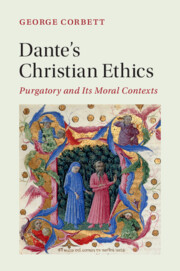Book contents
- Dante’s Christian Ethics
- Cambridge Studies in Medieval Literature
- Dante’s Christian Ethics
- Copyright page
- Contents
- Acknowledgements
- Editions Followed and Abbreviations
- Introduction
- Part I Ethical and Political Manifesto
- Part II Reframing Dante’s Christian Ethics
- Chapter 3 Dante’s Theological Purgatory
- Chapter 4 Two Traditions of Christian Ethics
- Part III Penance and Dante’s Purgatory
- Conclusion
- Bibliography
- Index
- Cambridge Studies in Medieval Literature
Chapter 4 - Two Traditions of Christian Ethics
Aquinas and Peraldus
from Part II - Reframing Dante’s Christian Ethics
Published online by Cambridge University Press: 28 February 2020
- Dante’s Christian Ethics
- Cambridge Studies in Medieval Literature
- Dante’s Christian Ethics
- Copyright page
- Contents
- Acknowledgements
- Editions Followed and Abbreviations
- Introduction
- Part I Ethical and Political Manifesto
- Part II Reframing Dante’s Christian Ethics
- Chapter 3 Dante’s Theological Purgatory
- Chapter 4 Two Traditions of Christian Ethics
- Part III Penance and Dante’s Purgatory
- Conclusion
- Bibliography
- Index
- Cambridge Studies in Medieval Literature
Summary
Scholars have typically turned to Aquinas’s Summa theologiae for the moral theology of Dante’s Purgatory. However Dante is, in fact, following an older, more conservative tradition of Christian ethics represented by Peraldus’s De vitiis et virtutibus. In the thirteenth century, theologians moved from trying to displace the structuring principle of the seven capital vices with other alternatives to reforming it from within, and Peraldus and Aquinas adopted markedly different approaches to this reform.
Peraldus’s rationale impels him to treat the vices separately, according to disordered love by excess or deficiency (gluttony, lust, avarice, and sloth) or to love of an evil (pride, envy, and anger). Aquinas, by contrast, introduces an Aristotelian anthropology and a new positive teleological frame, enabling him to treat vices and virtues together in terms of shared good objects desired or avoided. A comparative critique highlights the characteristics, including the weaknesses, of Dante’s poetic treatment (which clearly follows Peraldus’s treatise).
The parallel in ethical content between Peraldus and Dante is matched, furthermore, by a parallel in form: Peraldus’s De vitiis invites us to imagine Dante assuming in the Purgatorio the role of a venacular preacher against vice, with the reader envisaged as a Christian sinner.
- Type
- Chapter
- Information
- Dante's Christian EthicsPurgatory and Its Moral Contexts, pp. 86 - 104Publisher: Cambridge University PressPrint publication year: 2020



